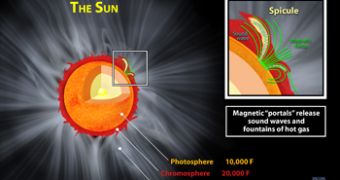A mystery about the interior of the Sun lasting for centuries has been solved by scientists at National Science Foundation (NSF) and NASA. They now proved that sound waves escape the interior of the sun and form fountains of hot gas that shape and provide fuel for a region of the sun's atmosphere.
This thin region, called chromosphere, appears as a ruby red "ring of fire" around the moon during a total solar eclipse and produces most of the deep ultraviolet radiation that hits the Earth's ozone layer and is believed to be in strong correlation with climate variations on Earth.
"The sun's interior vibrates with the peal of millions of bells, but the bells are all on the inside of the building," said Scott McIntosh of the Southwest Research Institute in Boulder, Colo., lead member of the research team. "We've been able to show how the sound can escape the building and travel a long way using the magnetic field as a guide."
That is in fact the explanation of a mystery that lasts for almost a century, since no one was able to explain why the sun's chromosphere and the corona above are much hotter than the visible surface of the star.
"It's getting warmer as you move away from the fire instead of cooler, certainly not what you would expect," said McIntosh.
"Scientists have long realized that observations of solar magnetic fields are the keys that will unlock the secrets of the sun's interior," said Paul Bellaire, program director in NSF's division of atmospheric sciences, which funded the research. "These researchers have found an ingenious way of using magnetic keys to pick those locks."
Scientists used three separate methods - computer simulations, terrestrial telescopes and spacecraft - to calculate how the magnetic field of the sun allows the release of energy from inside it in the form of sound waves that travel in the form of thin fountains into the upper chromosphere.
"This work finds the missing piece of the puzzle that has fascinated many generations of solar astronomers," said Alexei Pevtsov, program scientist at NASA. "If you fit this piece into place, the whole picture of chromosphere heating becomes more clear."

 14 DAY TRIAL //
14 DAY TRIAL //